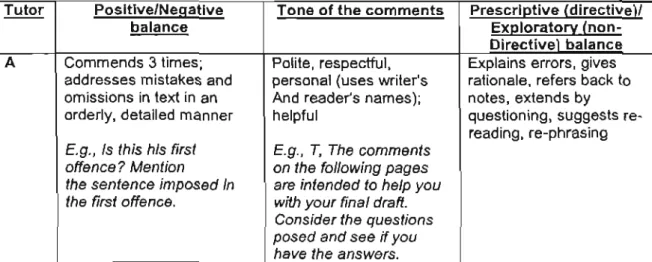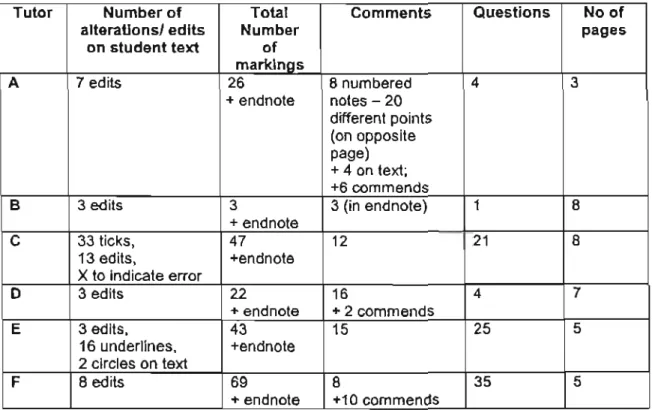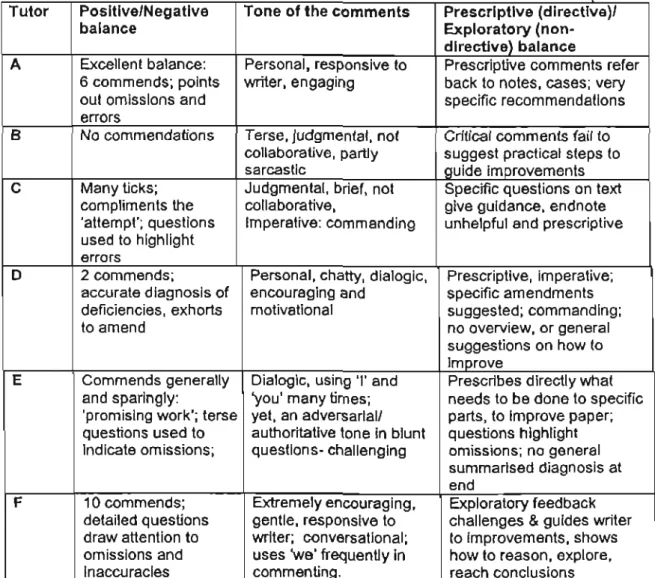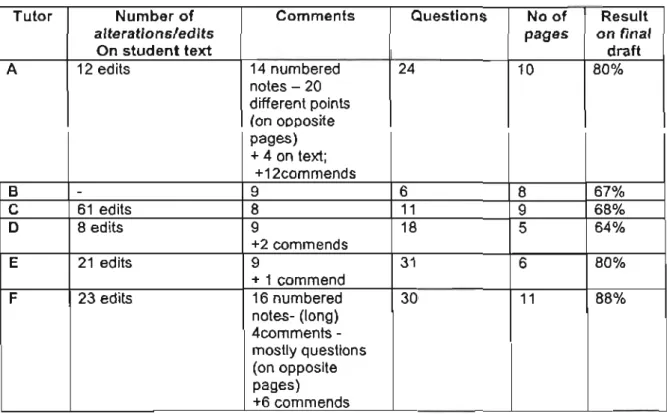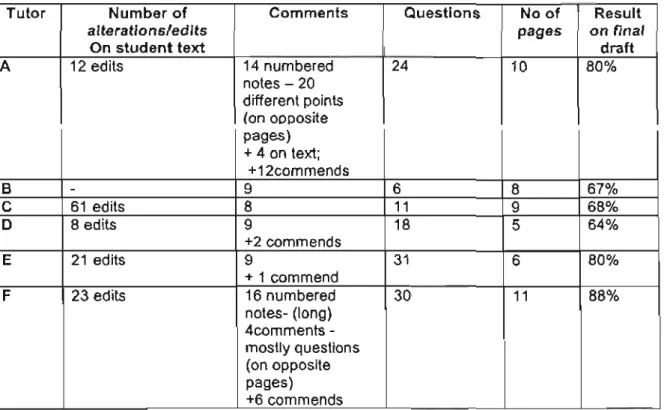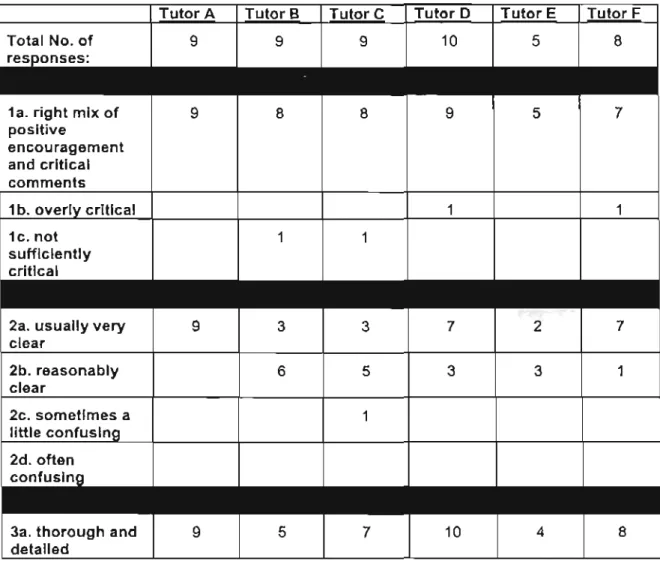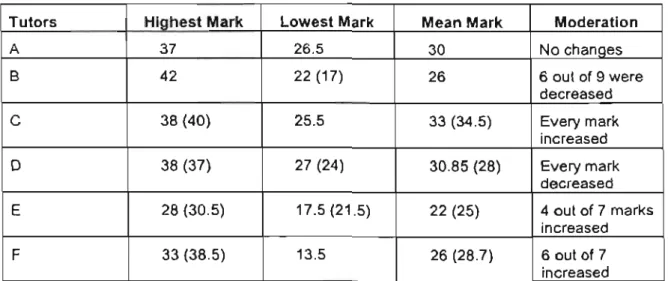A survey on the teaching of legal writing at South African law schools, to determine the context of the study, follows. This detailed evaluation of the tutors' work should provide an accurate sense of student tutors' shared abilities to assist in the teaching of legal writing. The nature of the investigation and the methodology resonated with the research undertaken in this study.
Analysis of the tutors' feedback comments
The relevant categories were: comments/questions about (1) understanding the task instructions; (2) accuracy of law/content; (3) organization of writing/form. Most of the results (with the exception of tutors B and D) contradict Siegel's findings where inexperienced writing instructors tended to identify almost as many content errors as form errors (a ratio of 3:4). Try to analyze each factor in light of Where the magistrate made this judgment.
For this reason, some feedback comment classifications and tables are varied. She mentions the lack of reflective analysis in the article – the need to 'make meaning' of the observations. A note with personal names on the front of the paper asks the student to make an appointment, and the end note summarizes the feedback.
So many changes in the text distract the writer from developing an overview of the positive and negative aspects of the paper. Mentor E: This mentor appropriately praises the writer for her effort and her understanding of the assignment requirements. Mentor's use of the writer's name three times and her comments such as: 'I'm glad.
The writer's attention to all aspects of the assignment instructions and her use of clear language are noted.
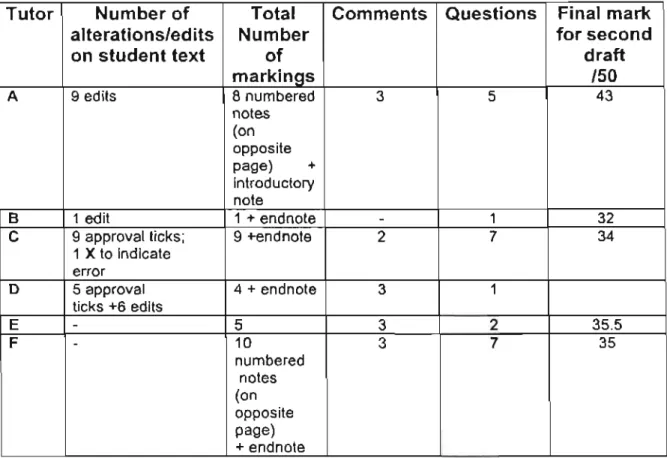
Tutors' self-assessment of their success in giving feedback
This narrow, instrumental interpretation of the purpose of feedback ignores the broader need to motivate extensive revisions of early drafts of texts (Sommers, 1992:281). However, the awareness of the need for balance in her criticism is reflected in: 'I try to motivate my students by praising them for tasks well done and by telling them honestly what I thought of their work and where they could make improvements' . Tutor E awarded herself 90% for her feedback, which was reduced to 76%, reflecting a significant difference between tutor and supervisor perceptions of the type of feedback expected.
It becomes clear that her sense of the priorities in commentary are not those presented in the lectures, or the workshop and training sessions. This tutor's reflective skills, her diligence in seeking a balance, not to discourage her students, reveal an uncertainty, a hesitation and a humility that is not present in any of the other tutors' self-assessments. Her internalization of the theory underlying feedback is evident in her appreciation of the difficulties of providing effective criticism.
Regarding the self-evaluation exercise, tutors A, C and F underestimated their grades, while tutors B, D and E assigned themselves higher grades than their tutors did on the feedback aspect of the course. Applying this to the tutors, Tutors Band D, whose self-assessments were inaccurate, had academic results in their final year that were significantly lower than those of the other tutors, but Tutor E, although academically successful, did not appear to have successfully internalized assessment criteria for this aspect of teaching legal skills.
Tutors' responses to my feedback questionnaire
Tutor C also emphasized negative criticism in the responses: 'correcting mistakes, perfecting writing styles', and tutor D stated: 'to inform if they should make changes, correct spelling and grammar mistakes, Polish arguments'. Almost predictably, the emphasis in tutors A and F's responses reflects a view that suggests 'coaching' the student writer. Tutor A comments: 'It helps writers improve their work and draws attention to their mistakes so they can improve their writing skills'.
While some believed that it was valuable to give examples and show the student how to edit her sentences, others preferred a more limited version of editing, characterized as: 'guidance is great; doing the student's work is not'. Tutor F was also concerned with 'making constructive recommendations as the students are freshmen and will remember the advice' - a comment that resonates with Jones's view that it should make effective comments that 'serve the writer for the long term' ( Enquist Tutor B expressed her concern by commenting on 'good writing, where there are no errors or omissions' - an unheard of category in student writing.
Mentor B commented, 'I know them personally, I know their attendance patterns', suggesting that she is responsive to the writing behaviours, personalities and individual problems of student writers. In response to this question, tutors A, E and F described the styles, techniques or processes they had developed to help them achieve their feedback goals.
Comparative Data
The cumulative average percentage of three of the six teachers had improved in the last academic year. It is impossible to determine whether participation in this course had a direct effect on their academic results, although each of the teachers in the questionnaire (Appendix 5) expressed the view that her writing skills had improved significantly by commenting on writing students. It is likely that the teachers' training in these areas was not in-depth enough.
In general terms, in their edits and corrections of students' texts, the teachers addressed some of the superficial discourse conventions. This chapter focuses on conclusions and recommendations for improving student teachers' commenting practice in three main areas, which emerged from the analysis in Chapter 4. The teachers' enthusiasm to provide writing assistance is reflected in most examples.
The least successful aspects of the tutors' feedback that emerged from the analysis of the samples were based on misunderstandings, related to the purpose of effective commenting on first drafts of student writing. This would be appropriate in light of the supervisors' responses to the feedback questionnaire, where most responded that they had little personal experience of receiving feedback on their own work.
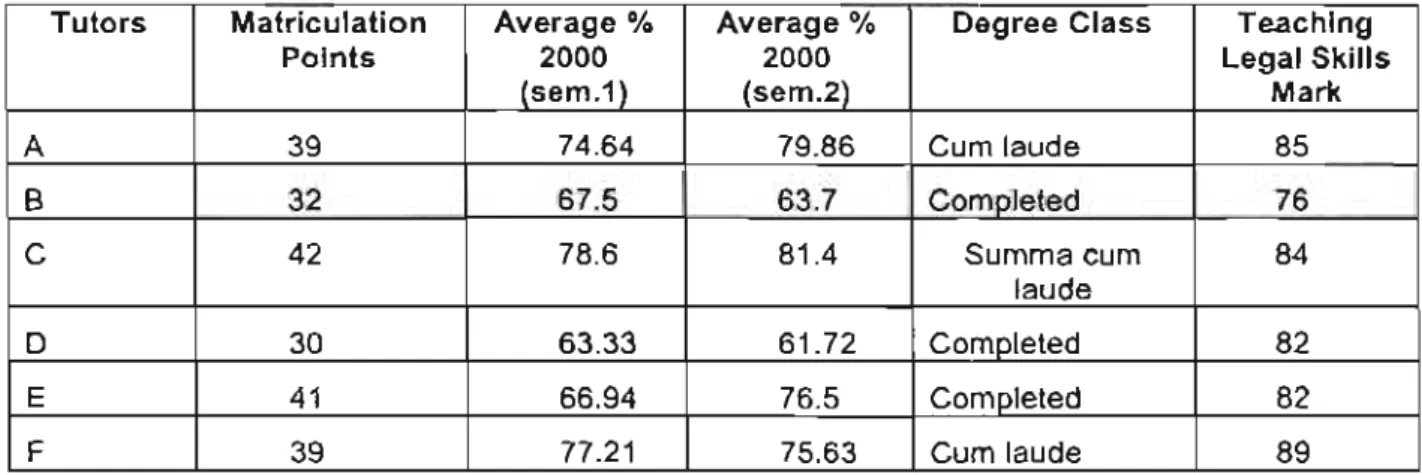
Recommendations for Improving Tutor Education
However, in a situation where tutors are being trained and their feedback can significantly influence the student's writing process and final product, it may be necessary to implement a more structured system aimed at standardizing or monitoring the tutors' responses to a limited extent, for the benefit of the students. Methods such as peer review (by another tutor) of comments, printed feedback forms, review by supervisors of papers before they are returned to students, or at least random sample checks could be considered. More prescriptive, minimum requirements could be set by tutors for each assignment, or tutors could be given a sample assignment for each assignment with examples of what would be considered effective comments (prepared by tutors or from previous year's assignments).
It would be much more rigorous than the current training, and would expand the training workshop. It is much more time-consuming and labor-intensive than the training that the tutors undergo, but it clearly has many advantages. Currently, very little practice is given before they start commenting, despite the fact that most of them have not been exposed to much feedback on their own writing.
Other practical ways to improve the tutors' training would be: building a library of resources focusing on feedback, such as theoretical lectures, examples of comments written by experienced teachers on previous assignments, and the development of detailed tutor memoranda, which the purpose of each writing assignment, and specify the feedback priorities for each paper. A system of 'pairing' different tutors for each assignment, to facilitate peer reviews of their feedback comments, will promote collaborative formation between the tutors, encourage reflective exchanges between them and keep the supervisors' workload within reasonable limits.
Supervision and monitoring of tutors' feedback comments
A 'checklist' for peer reviews, drawn up by the course supervisors, would ensure minimal compliance with certain prescribed elements in the tutors' feedback, for example there is a summarizing final note that prioritizes the three main areas to be revised. Although this could not guarantee responsive, focused commentary, it would achieve a degree of coherence in the tutors' efforts and establish normative 'baselines' in a formalistic way. Alternatively, a “self-check” list that mentees can submit to their mentee can monitor the frequency and nature of their feedback comments, help reinforce mentee expectations, and promote the development of mentees' self-evaluation skills.
Short student evaluation forms for each assignment that require students to write their responses to tutors' feedback will provide ongoing valuable information to tutors and could be an effective assessment tool to document tutors' progress in this area. In summary, the analysis of the tutors' feedback comments confirms the value, the viability and the possibility of improving the potential benefits for all participants affected by a tutor training program using fourth-year students to help develop the writing skills of first-year law students. The study confirms that tutoring students have the capacity, with appropriate training, support and supervision, to expand teaching resources, to develop effective commenting techniques and thereby help teach legal writing.
Revised version of a paper presented with Woolever, K.R at the Legal Writing Institute Conference, Ann Arbor, July 1990. Voices in the Wilderness: Directors and Teachers in Legal Research and Writing Programs.
Deans' Questionnaire
What do you consider to be the obstacles and constraints to teaching legal writing in the LLB curriculum. This uncertainty arises because of the interplay between legal and factual research in problem formulation and analysis. Today we have two main areas to cover: the analytical concept of legal interpretation and the formal requirements in the client letter.
In each section below (a, b, c, d, e and f), tick the ONE sentence that applies to your supervisor's comments on your written work:. Tick the word that describes your tutor's ability to help you learn legal analysis and writing: . [ ] excellent [ ) excellent ( ] very good [ 1 good [ 1 fair [ 1 poor. General comments on your tutor's performance and the tutoring system in the Foundations of SA Law.
At the beginning of the year, what were your thoughts on first and final drafts of written exercises. And most of them were there to drop charges and get their cases out of court.

